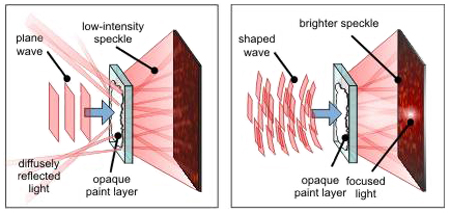Materials such as milk, paper, white paint and tissue are opaque because they scatter light, not because they absorb it, but no matter how great the scattering, light was always able to get through the material in question, went the theory.
Researchers Ivo Vellekoop and Allard Mosk of the University of Twente have now shaped the waveform of light and confirmed this with experiments. By doing so they have found the predicted ‘open channels’ in material along which the light is able to move.
In materials that have a disordered structure, incident light is scattered in every direction possible. In an opaque layer, so much scattering takes place that barely any light comes out ‘at the back.’ However, even a material that causes a great deal of light scattering has channels along which light can propagate. This is only possible if the light meets strict preconditions so that the scattered light waves can reinforce one another on the way to the exit.

By manipulating the waveform of light, Vellekoop and Mosk have succeeded in finding these open channels. They used an opaque layer of the white pigment, zinc oxide, which was in use by painters such as Van Gogh. Only a small part of the original laser light that falls on the zinc oxide, as a plane wave, is allowed through.
As every painter knows, the thicker the paint coating, the less light it will let through. By using information about the light transmitted to program the laser, the researchers shaped the waveform to the optimum form to get it to pass through the open channels. To this end, parts of the incident wave were slowed down to allow the scattered light to interfere in precisely the right manner with other parts of the same wave.
In this way, Vellekoop and Mosk increased the amount of light allowed through by no less than 44 percent. As theoreticians had predicted, open channels can always be found and transmission through them is, furthermore, independent of the thickness of the material concerned.
The results are remarkable: although the theoretical existence of open channels was acknowledged, so far manipulating the light such that the channels in materials could actually be found has been too complex. As a result of better light conductivity in opaque materials, it may in the future be easier to look into materials that have so far not divulged their secrets: for example in medical imaging technology. There is a significant parallel with the conductivity of electrons in extremely thin wires, such as those on semi-conductor chips. Electrons, which according to quantum mechanics behave as waves, move through these same open channels.
It is also conceivable that this research will yield more information about waveforms other than light, such as radio waves for mobile communication: can the range be improved by adjusting the waveform.
This research was carried out in the Complex Photonic Systems group of the University of Twente’s MESA+ Institute for Nanotechnology. It is financed by the Foundation for Fundamental Research on Matter (FOM) and by a Vidi grant from the Netherlands Organization for Scientific Research (NWO).
The results will soon be published in Physical Review Letters





Comments